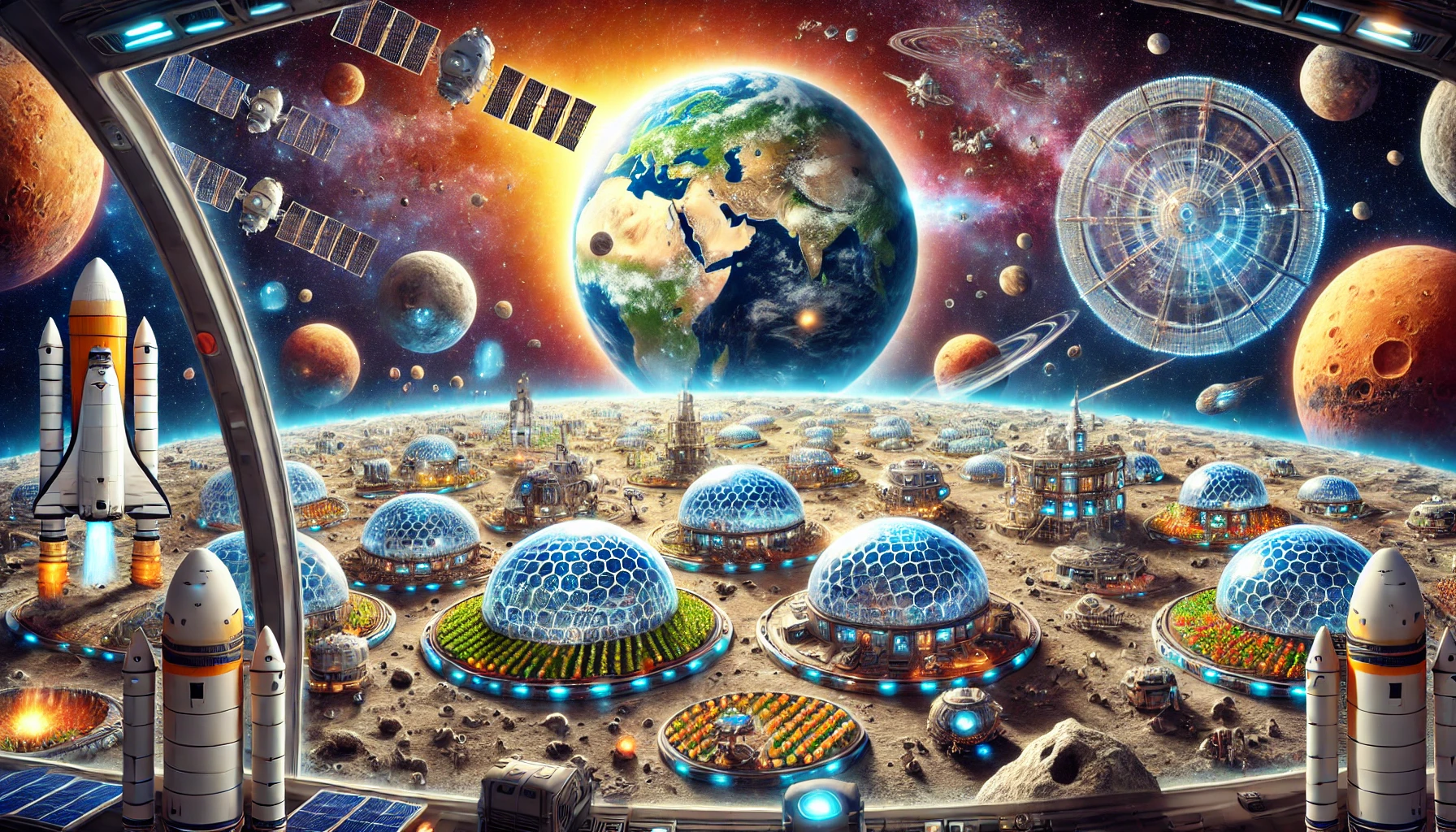Humanity stands on the brink of its most ambitious venture: colonising the Solar System. This initiative would not only ensure our survival as a species but also inspire new technologies and open infinite opportunities for growth. Let’s explore how we can make this dream a reality.
SUMMARY
The Problem: The Earth is increasingly under strain from climate change, overpopulation, and resource scarcity. Relying solely on our home planet is a risk to humanity’s survival.
The Solution: Establish permanent colonies across the Solar System, utilising advanced technologies for transportation, habitation, and resource extraction.
Key Stakeholders: Governments, space agencies, private companies, scientists, and the global public must collaborate to make this a reality.
CONTEXT
Space exploration is no longer the stuff of science fiction. With SpaceX launching reusable rockets, NASA planning lunar missions, and initiatives like the Artemis Accords fostering international collaboration, we stand on the cusp of interplanetary living. Yet, Earth’s challenges—climate instability, dwindling resources, and geopolitical tensions—are accelerating the urgency to expand beyond our home planet. Colonising the Solar System offers a solution that ensures humanity’s long-term survival.
CHALLENGES
- Extreme Environments
Conditions on other planets and moons are hostile—freezing temperatures, lack of oxygen, and radiation levels far beyond Earth’s. - Technological Limitations
Current spacecraft are expensive and slow, making interplanetary travel impractical for mass migration. - High Costs
Developing, launching, and sustaining off-world colonies involves staggering financial commitments. - Ethical Concerns
Issues such as planetary protection, indigenous life (if discovered), and socio-economic inequality must be addressed. - Sustainability
Colonies must be self-sufficient, minimising dependence on Earth for supplies.
GOALS
Short-Term (2024-2034):
- Establish a permanent Moon base as a testing ground for off-world habitats.
- Develop next-generation propulsion technologies for faster travel.
Long-Term (2035-2050):
- Build sustainable colonies on Mars and select moons (e.g., Europa, Titan).
- Establish asteroid mining operations for resources.
- Develop governance systems for interplanetary living.
STAKEHOLDERS
- Governments: Fund research, enforce international treaties, and establish infrastructure.
- Private Sector: Innovate in transportation, robotics, and resource extraction.
- Space Agencies: Lead research, missions, and technical expertise (e.g., NASA, ESA, ISRO).
- Academia: Provide scientific research and training.
- Global Citizens: Advocate for ethical and inclusive space exploration policies.
SOLUTION
1. Establishing a Lunar Base
The Moon serves as an ideal starting point, offering proximity to Earth and opportunities to develop critical technologies.
- What It Involves:
A modular habitat with radiation shielding, in-situ resource utilisation (ISRU) for oxygen and water extraction, and solar farms for energy. - Challenges Addressed:
Testing life-support systems, refining resource extraction, and building interplanetary supply chains. - Cost: $35 billion over 10 years.
2. Developing Interplanetary Transport
Travel across the Solar System requires faster, safer, and cost-effective propulsion systems.
- What It Involves:
Advancing nuclear thermal propulsion (NTP) and ion drives, reducing travel time to Mars to under three months. - Innovation:
NTP offers ten times the efficiency of chemical rockets. - Cost: $20 billion for research and development.
3. Terraforming Mars and Titan Habitats
Mars offers the most Earth-like conditions, while Titan’s hydrocarbon reserves make it a key energy hub.
- What It Involves:
Deploying robotic systems to build habitats and shield colonists from radiation. Greenhouses for food production and algae bio-reactors for oxygen generation. - Sustainability:
ISRU to harvest water, CO₂, and minerals for building materials and fuel. - Cost: $100 billion over 20 years.
4. Asteroid Mining Operations
Asteroids are rich in metals like platinum and rare earth elements essential for building colonies.
- What It Involves:
Autonomous mining robots, 3D printing for manufacturing in space, and returning valuable materials to Earth. - Scalability:
Mining profits can fund further exploration. - Cost: $50 billion for deployment.
5. Governance and Ethical Frameworks
Creating systems to manage interplanetary colonies, ensuring equity, and addressing planetary protection.
- What It Involves:
International agreements for resource-sharing, guidelines to prevent contamination of celestial bodies, and governance structures for interplanetary societies. - Cost: $5 billion to establish policies and governance bodies.
IMPLEMENTATION
Timeline:
- 2024-2028: Lunar base construction and propulsion R&D.
- 2029-2035: First Mars missions and asteroid mining tests.
- 2036-2050: Expansion to Mars, Titan, and large-scale resource extraction.
Resources Needed:
- Human: 10,000 scientists, engineers, and construction workers.
- Financial: $210 billion total.
- Technological: Advanced robotics, nuclear reactors, and communication networks.
Risk Mitigation:
- Redundant life-support systems.
- Autonomous repair robots.
- International collaboration to share costs and expertise.
Monitoring:
- Periodic reviews by space agencies.
- Data-sharing among stakeholders.
FINANCIALS
| Element | Cost | Funding Source |
|---|---|---|
| Lunar Base | $35 billion | National budgets (NASA, ESA, etc.) |
| Transport R&D | $20 billion | Private sector investment (SpaceX, Blue Origin) |
| Mars/Titan Habitats | $100 billion | Global consortium of nations |
| Asteroid Mining | $50 billion | Mining corporations, asteroid resource bonds |
| Governance Frameworks | $5 billion | UN-backed initiatives, philanthropic funding |
| Total | $210 billion | $220 billion secured (10% contingency) |
CASE STUDIES
- International Space Station (ISS): Demonstrates the viability of multinational cooperation in space.
- SpaceX Reusable Rockets: Lowered launch costs by 80%, showcasing the potential for scalable space ventures.
- Biosphere 2 Experiments: Provided insights into closed-loop ecosystems essential for space colonies.
IMPACT
Quantitative:
- $10 trillion in new resources (minerals, energy).
- Reduction in Earth’s resource strain by 15%.
- Creation of 2 million jobs globally in aerospace, science, and related fields.
Qualitative:
- Strengthened global collaboration.
- Expansion of human knowledge and culture.
- Inspiration for future generations.
CALL TO ACTION
Humanity must unite to expand our presence across the Solar System. Governments, companies, and individuals are called to invest, innovate, and inspire. The next steps involve securing funding, launching pilot projects, and creating policies for sustainable colonisation. Let’s ensure our survival by looking to the stars.

Leave a Reply